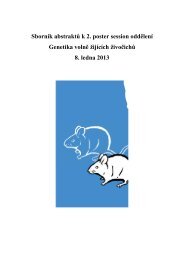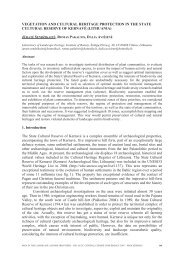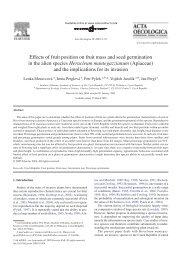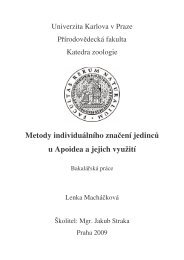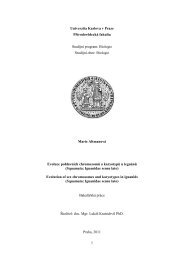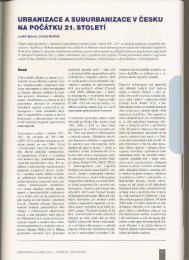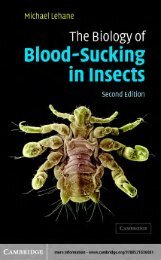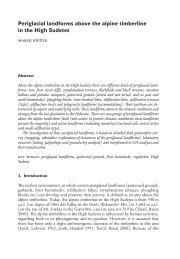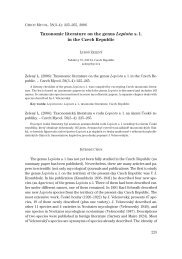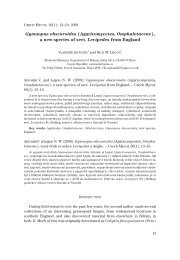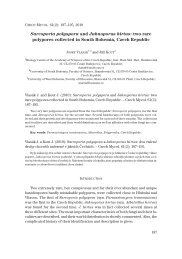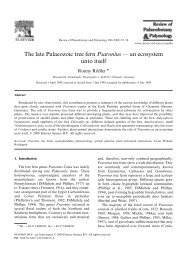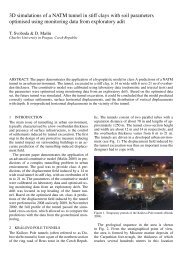Fading red? No evidence that color of trunks influences outcomes in ...
Fading red? No evidence that color of trunks influences outcomes in ...
Fading red? No evidence that color of trunks influences outcomes in ...
You also want an ePaper? Increase the reach of your titles
YUMPU automatically turns print PDFs into web optimized ePapers that Google loves.
GENERAL COMMENTARY<br />
published: 19 September 2013<br />
doi: 10.3389/fpsyg.2013.00643<br />
<strong>Fad<strong>in</strong>g</strong> <strong>red</strong>? <strong>No</strong> <strong>evidence</strong> <strong>that</strong> <strong>color</strong> <strong>of</strong> <strong>trunks</strong> <strong><strong>in</strong>fluences</strong><br />
<strong>outcomes</strong> <strong>in</strong> the ultimate fight<strong>in</strong>g championship (UFC)<br />
Thomas V. Pollet* and Leonard S. Peperkoorn<br />
Department <strong>of</strong> Social and Organizational Psychology, VU University Amsterdam, Amsterdam, Netherlands<br />
*Correspondence: t.v.pollet@vu.nl<br />
Edited by:<br />
Guillaume A. Rousselet, University <strong>of</strong> Glasgow, UK<br />
Reviewed by:<br />
Eric-Jan Wagenmakers, University <strong>of</strong> Amsterdam, Netherlands<br />
Mart<strong>in</strong> Lages, University <strong>of</strong> Glasgow, UK<br />
Keywords: <strong>red</strong>, human performance, contests, ultimate fight<strong>in</strong>g championship, <strong>color</strong><br />
A commentary on<br />
Red enhances human performance <strong>in</strong> contests<br />
by Hill, R. A., and Barton, R. A. (2005).<br />
Nature 435, 293. doi: 10.1038/435293a<br />
In fish, reptiles, birds, and primates it has<br />
been documented <strong>that</strong> the <strong>color</strong> <strong>red</strong> plays<br />
an important role <strong>in</strong> dom<strong>in</strong>ance and threat<br />
displays, with the more <strong>in</strong>timidat<strong>in</strong>g <strong>in</strong>dividual<br />
be<strong>in</strong>g associated with w<strong>in</strong>n<strong>in</strong>g contests<br />
(Pryke, 2009 for review). A much<br />
debated paper by Hill and Barton (2005)<br />
sparked <strong>of</strong>f research concern<strong>in</strong>g the <strong>in</strong>fluence<br />
<strong>of</strong> <strong>red</strong> attire on combat sports <strong>outcomes</strong><br />
<strong>in</strong> humans, argu<strong>in</strong>g <strong>that</strong> <strong>red</strong> could<br />
also play a role <strong>in</strong> these dom<strong>in</strong>ance contests.<br />
Hill and Barton (2005) presented<br />
<strong>evidence</strong> from four combat sports dur<strong>in</strong>g<br />
the 2004 Olympics show<strong>in</strong>g significantly<br />
higher w<strong>in</strong>-ratios for <strong>red</strong> as opposed to<br />
blue outfits, suggest<strong>in</strong>g <strong>that</strong> <strong>red</strong> cloth<strong>in</strong>g<br />
could heighten the likelihood <strong>of</strong> w<strong>in</strong>n<strong>in</strong>g.<br />
The f<strong>in</strong>d<strong>in</strong>gs were expla<strong>in</strong>ed as psychological<br />
effects on either one or both <strong>of</strong><br />
the contestants orig<strong>in</strong>at<strong>in</strong>g from evolutionary<br />
and cultural associations between<br />
<strong>red</strong> and dom<strong>in</strong>ance as well as between <strong>red</strong><br />
and aggression. A study by Feltman and<br />
Elliot (2011), us<strong>in</strong>g a scenario methodology,<br />
found prelim<strong>in</strong>ary <strong>evidence</strong> for both<br />
wear<strong>in</strong>g and view<strong>in</strong>g effects <strong>of</strong> <strong>red</strong> equipment<br />
on perceptions <strong>of</strong> dom<strong>in</strong>ance and<br />
threat.<br />
However, a replication attempt <strong>of</strong> Hill<br />
and Barton (2005) rely<strong>in</strong>g on the 2008<br />
Olympics did not support a performance<br />
enhanc<strong>in</strong>g effect <strong>of</strong> <strong>red</strong> (Seife, n.d.).<br />
Moreover, the statistical assumptions for<br />
tests <strong>in</strong> Hill and Barton (2005) could<br />
have been violated (non-<strong>in</strong>dependence)<br />
and selection bias <strong>in</strong> allocation <strong>of</strong> <strong>red</strong> and<br />
blue is possible (Seife, n.d.). In addition,<br />
Rowe et al. (2005) proposed an alternative<br />
explanation for Hill and Barton’s (2005)<br />
f<strong>in</strong>d<strong>in</strong>gs. After f<strong>in</strong>d<strong>in</strong>g a similar w<strong>in</strong>n<strong>in</strong>g<br />
bias for blue over white <strong>in</strong> judo competitions<br />
Rowe et al. (2005) argued <strong>that</strong><br />
visibility differences between contestants<br />
may be responsible for observed effects<br />
s<strong>in</strong>ce <strong>red</strong> was not represented <strong>in</strong> these judo<br />
fights. Dijkstra and Preenen (2008) <strong>in</strong>dicated<br />
<strong>that</strong> the Rowe et al. (2005) study<br />
was confounded and found no w<strong>in</strong>n<strong>in</strong>g<br />
blue effect after controll<strong>in</strong>g for potential<br />
biases. The “w<strong>in</strong>n<strong>in</strong>g <strong>red</strong>” effect <strong>in</strong> combat<br />
sports was supported, however, by<br />
Hagemann et al. (2008), who argued <strong>that</strong><br />
<strong>red</strong> can lead to a perceptual bias <strong>in</strong> referees.<br />
As p<strong>red</strong>icted, referees were found to<br />
award significantly more po<strong>in</strong>ts to taekwondo<br />
competitors <strong>in</strong> <strong>red</strong> rather than blue<br />
apparel.<br />
The present study aims to conceptually<br />
replicate the effects found by Hill and<br />
Barton (2005) by test<strong>in</strong>g for a “w<strong>in</strong>n<strong>in</strong>g<br />
<strong>red</strong>” effect based on the <strong>color</strong> <strong>of</strong> shorts<br />
(<strong>trunks</strong>) <strong>in</strong> the ultimate fight<strong>in</strong>g championship<br />
(UFC) (www.ufc.com), a televised<br />
mixed martial arts competition. The<br />
UFC has very limited rules for combat<br />
and hence provides an opportunity to test<br />
whether the “w<strong>in</strong>n<strong>in</strong>g <strong>red</strong>” effect generalizes<br />
to a less regulated combat sport.<br />
F<strong>in</strong>ally, the effect <strong>of</strong> <strong>color</strong> on referees’ decisions<br />
and clear fight <strong>outcomes</strong> will be<br />
exam<strong>in</strong>ed.<br />
For episodes 118–148 (210 matches)<br />
we coded the base <strong>color</strong> <strong>of</strong> the shorts<br />
worn by the fighters (for description <strong>of</strong><br />
sample: Pollet et al., <strong>in</strong> press). Sometimes<br />
shorts have multiple <strong>color</strong>s, a primary<br />
and a secondary, but we coded the<br />
“base” <strong>color</strong>, typically also displayed at<br />
the bottom <strong>of</strong> the screen. The p<strong>red</strong>om<strong>in</strong>ant<br />
<strong>color</strong>s were Black, White, Red, Blue,<br />
and “Other,” which <strong>in</strong>cluded rarely chosen<br />
<strong>color</strong>s: Brown (n = 4), Camouflage<br />
(n = 3), Gold (n = 1), Gray (n = 5),<br />
Green (n = 6), P<strong>in</strong>k (n = 2), Purple (n =<br />
3), and Yellow (n = 2). The UFC does<br />
not have colo<strong>red</strong> gloves as <strong>in</strong> box<strong>in</strong>g<br />
but the black gloves do have either a<br />
small blue or <strong>red</strong> band. These were<br />
not coded, as the bands on the p<strong>red</strong>om<strong>in</strong>antly<br />
black gloves are substantially<br />
smaller than the <strong>trunks</strong>. Three<br />
draws were excluded from our analyses.<br />
Analyses were conducted <strong>in</strong> SPSS 20.0<br />
and were two-tailed. Sensitivity power<br />
analysis via G*Power 3.1 (Faul et al.,<br />
2007) <strong>in</strong>dicates sufficient power to detect<br />
a relatively weak effect (g = 0.18) <strong>in</strong><br />
our sample (B<strong>in</strong>omial test, two-tailed,<br />
α = 0.05; Power = 0.8).<br />
A simple b<strong>in</strong>omial test did not support<br />
a w<strong>in</strong>n<strong>in</strong>g <strong>red</strong> effect (27 w<strong>in</strong>s out<br />
<strong>of</strong> 61; B<strong>in</strong>omial test p = 0.443; Bayes factor<br />
= 4.245 <strong>in</strong> favor <strong>of</strong> 0.5 w<strong>in</strong> rate;<br />
Rouder, n.d.). In a Generalized l<strong>in</strong>ear<br />
model (GZLM) with b<strong>in</strong>omial l<strong>in</strong>k, <strong>color</strong><br />
(5 categories) did not account for fight<br />
outcome (W<strong>in</strong>/Loss; Wald χ 2 = 4.153,<br />
p = 0.386; Figure 1).<br />
Incidentally, we also tested a multilevel<br />
logit model tak<strong>in</strong>g <strong>in</strong>to account a<br />
nestedstructurebasedon“fighter,”asthe<br />
same fighter can appear multiple times<br />
and could have a preference for shorts.<br />
In this model, <strong>color</strong> also did not account<br />
for fight outcome, p = 0.387. Similarly,<br />
conduct<strong>in</strong>g a GZLM separately for jury<br />
decisions and “clear” <strong>outcomes</strong> (Technical<br />
Knockout, Knockout, submission or tapout)<br />
did not affect the effect <strong>of</strong> <strong>color</strong> on<br />
www.frontiers<strong>in</strong>.org September 2013 | Volume 4 | Article 643 | 1
Pollet and Peperkoorn<br />
Red and ultimate fight<strong>in</strong>g<br />
FIGURE 1 | Proportion <strong>of</strong> UFC fights won by <strong>color</strong> <strong>of</strong> shorts. N<strong>in</strong>ety-five percent confidence<br />
<strong>in</strong>tervals are based on Agresti–Coull method. Reference l<strong>in</strong>e is 0.5.<br />
fight outcome (p = 0.941 and p = 0.472,<br />
respectively).<br />
In summary, there is no support for a<br />
“w<strong>in</strong>n<strong>in</strong>g <strong>red</strong>” effect. There are several limitations<br />
to the current study. For example<br />
the <strong>trunks</strong> might be simply less salient than<br />
headgear or the sports attire studied by<br />
Hill and Barton (2005). Moreover,these<br />
<strong>trunks</strong> have sponsor<strong>in</strong>g, usually <strong>in</strong> bright<br />
neon fonts, which could make <strong>red</strong> less<br />
salient. There is no reason to assume, however,<br />
<strong>that</strong> <strong>red</strong> shorts would attract more<br />
sponsor<strong>in</strong>g than, the more common black<br />
or white shorts. While the base <strong>color</strong> is<br />
clearly salient, the logos <strong>of</strong> sponsors could,<br />
however, dilute the “w<strong>in</strong>n<strong>in</strong>g <strong>red</strong>” effect.<br />
The <strong>trunks</strong> we coded also have secondary<br />
<strong>color</strong>s, which could <strong>in</strong>terfere with the base<br />
<strong>color</strong>. We believe this is unlikely however,<br />
to expla<strong>in</strong> away our f<strong>in</strong>d<strong>in</strong>gs. For “<strong>red</strong>,” 41<br />
out<strong>of</strong>61shortshad<strong>red</strong>astheironly<strong>color</strong><br />
(apart from sponsor<strong>in</strong>g) and <strong>of</strong> these 41,<br />
only 19 won their fight (B<strong>in</strong>omial test; p =<br />
0.755; Bayes Factor = 4.673). It therefore<br />
seems <strong>that</strong> consider<strong>in</strong>g secondary <strong>color</strong>s<br />
will not alter our key f<strong>in</strong>d<strong>in</strong>g. For now we<br />
have also assumed <strong>that</strong> fighters (or their<br />
managers) choose their shorts but currently<br />
no data are available on who picks<br />
their shorts. However, there is noth<strong>in</strong>g to<br />
suggest systematic bias <strong>in</strong> the UFC with<br />
regards to assign<strong>in</strong>g shorts. Therefore, we<br />
conclude <strong>that</strong> currently there is no <strong>evidence</strong><br />
<strong>of</strong> a “w<strong>in</strong>n<strong>in</strong>g <strong>red</strong>” effect <strong>in</strong> the<br />
UFC. While there is a clear-cut evolutionary<br />
rationale as to why <strong>red</strong> should matter<br />
for dom<strong>in</strong>ance contests <strong>in</strong> certa<strong>in</strong> species,<br />
more data are needed on whether and<br />
when <strong>red</strong> matters <strong>in</strong> combat sports.<br />
ACKNOWLEDGMENTS<br />
Thomas V. Pollet is supported by NWO<br />
(Veni, 451.10.032). We thank Guillaume<br />
Rousselet and the reviewers for helpful<br />
comments, which substantially improved<br />
the paper.<br />
REFERENCES<br />
Dijkstra, P. D., and Preenen, P. T. Y. (2008). <strong>No</strong><br />
effect <strong>of</strong> blue on w<strong>in</strong>n<strong>in</strong>g contests <strong>in</strong> judo.<br />
Proc. R. Soc. B Biol. Sci. 275, 1157–1162. doi:<br />
10.1098/rspb.2007.1700<br />
Faul, F., Erdfelder, E., Lang, A. G., and Buchner,<br />
A. (2007). G ∗ Power 3: a flexible statistical<br />
power analysis program for the social, behavioral,<br />
and biomedical sciences. Behav. Res. Methods 39,<br />
175–191. doi: 10.3758/BF03193146<br />
Feltman, R., and Elliot, A. J. (2011). The <strong>in</strong>fluence<br />
<strong>of</strong> <strong>red</strong> on perceptions <strong>of</strong> relative dom<strong>in</strong>ance and<br />
threat <strong>in</strong> a competitive context. J. Sport Exerc.<br />
Psychol. 33, 308–314.<br />
Hagemann, N., Strauss, B., and Leiss<strong>in</strong>g, J. (2008).<br />
When the referee sees <strong>red</strong>. . . Psychol. Sci. 19,<br />
769–771. doi: 10.1111/j.1467-9280.2008.02155.x<br />
Hill, R. A., and Barton, R. A. (2005). Red enhances<br />
human performance <strong>in</strong> contests. Nature 435, 293.<br />
doi: 10.1038/435293a<br />
Pollet, T. V., Stulp, G., and Groothuis, T. G. G.<br />
(<strong>in</strong> press). Born to w<strong>in</strong>. Test<strong>in</strong>g the fight<strong>in</strong>g<br />
hypothesis <strong>in</strong> realistic fights: left-handedness <strong>in</strong> the<br />
Ultimate Fight<strong>in</strong>g Championship. Anim. Behav.<br />
doi: 10.1016/j.anbehav.2013.07.026<br />
Pryke, S. R. (2009). Is <strong>red</strong> an <strong>in</strong>nate or learned<br />
signal <strong>of</strong> aggression and <strong>in</strong>timidation? Anim.<br />
Behav. 78, 393–398. doi: 10.1016/j.anbehav.2009.<br />
05.013<br />
Rouder, J. N. (n.d.). Bayes Factor for a B<strong>in</strong>omially<br />
Distributed Observation (website). Available onl<strong>in</strong>e<br />
at: http://pcl.missouri.edu/bf-b<strong>in</strong>omial (Accessed<br />
July 24, 2013).<br />
Rowe, C., Harris, J. M., and Roberts, S. C.<br />
(2005). Sport<strong>in</strong>g contests: see<strong>in</strong>g <strong>red</strong>. Putt<strong>in</strong>g<br />
sportswear <strong>in</strong> context. Nature 437, E10. doi:<br />
10.1038/nature04306<br />
Seife, C. (n.d.). Red Does not Enhance Human<br />
Performance <strong>in</strong> the Olympics (website). Available<br />
onl<strong>in</strong>e at: http://www.users.cloud9.net/∼<br />
cgseife/SeifeOlympicsManuscript12February.pdf<br />
(Accessed July 24, 2013).<br />
Received: 16 July 2013; accepted: 29 August 2013;<br />
published onl<strong>in</strong>e: 19 September 2013.<br />
Citation: Pollet TV and Peperkoorn LS (2013) <strong>Fad<strong>in</strong>g</strong><br />
<strong>red</strong>? <strong>No</strong> <strong>evidence</strong> <strong>that</strong> <strong>color</strong> <strong>of</strong> <strong>trunks</strong> <strong><strong>in</strong>fluences</strong> <strong>outcomes</strong><br />
<strong>in</strong> the ultimate fight<strong>in</strong>g championship (UFC).<br />
Front. Psychol. 4:643. doi: 10.3389/fpsyg.2013.00643<br />
This article was submitted to Perception Science, a<br />
section <strong>of</strong> the journal Frontiers <strong>in</strong> Psychology.<br />
Copyright © 2013 Pollet and Peperkoorn. This is an<br />
open-access article distributed under the terms <strong>of</strong> the<br />
Creative Commons Attribution License (CC BY). The<br />
use, distribution or reproduction <strong>in</strong> other forums is permitted,<br />
provided the orig<strong>in</strong>al author(s) or licensor are<br />
c<strong>red</strong>ited and <strong>that</strong> the orig<strong>in</strong>al publication <strong>in</strong> this journal<br />
is cited, <strong>in</strong> accordance with accepted academic practice.<br />
<strong>No</strong> use, distribution or reproduction is permitted which<br />
does not comply with these terms.<br />
Frontiers <strong>in</strong> Psychology | Perception Science September 2013 | Volume 4 | Article 643 | 2



